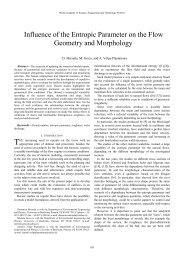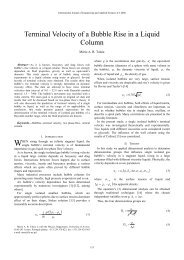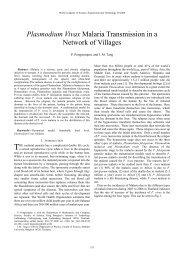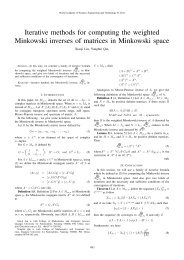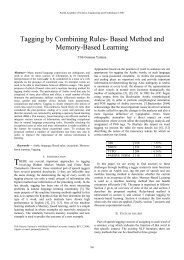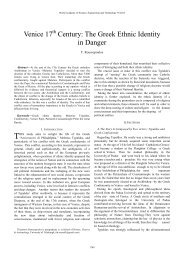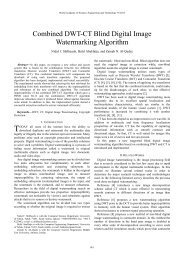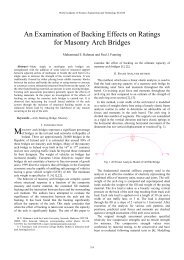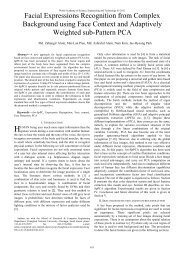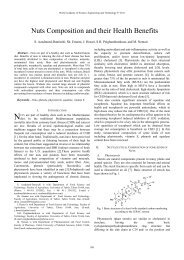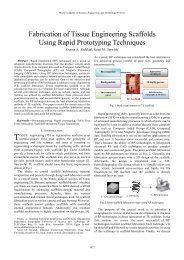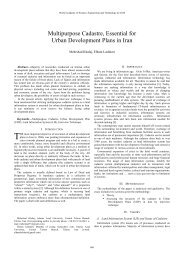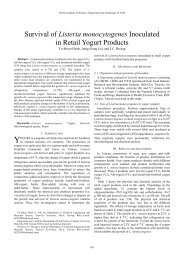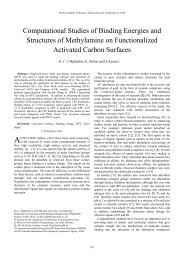Influence of Bentonite Additive on Bitumen and Asphalt Mixture ...
Influence of Bentonite Additive on Bitumen and Asphalt Mixture ...
Influence of Bentonite Additive on Bitumen and Asphalt Mixture ...
Create successful ePaper yourself
Turn your PDF publications into a flip-book with our unique Google optimized e-Paper software.
World Academy <str<strong>on</strong>g>of</str<strong>on</strong>g> Science, Engineering <strong>and</strong> Technology 68 2012<br />
<str<strong>on</strong>g>Influence</str<strong>on</strong>g> <str<strong>on</strong>g>of</str<strong>on</strong>g> <str<strong>on</strong>g>Bent<strong>on</strong>ite</str<strong>on</strong>g> <str<strong>on</strong>g>Additive</str<strong>on</strong>g> <strong>on</strong> <strong>Bitumen</strong> <strong>and</strong><br />
<strong>Asphalt</strong> <strong>Mixture</strong> Properties<br />
Ziari Hassan, Div<strong>and</strong>ari Hassan, Babagoli Rezvan, Akbari Ali<br />
<br />
Abstract—<strong>Asphalt</strong> surfaces are exposed to various weather With all the stated advantages, using filler more than what is<br />
c<strong>on</strong>diti<strong>on</strong>s <strong>and</strong> dynamic loading caused by passing trucks <strong>and</strong><br />
vehicles. In such situati<strong>on</strong>s, asphalt cement shows so different<br />
rheological-mechanical behavior. If asphalt cement isn’t compatible<br />
enough, asphalt layer will be damaged immediately <strong>and</strong> expensive<br />
repairing procedures should be performed then. To overcome this<br />
problem, researchers study <strong>on</strong> mechanical improved asphalt cement.<br />
needed may lead to reducti<strong>on</strong> in the porosity <strong>and</strong> increasing<br />
the stiffness <str<strong>on</strong>g>of</str<strong>on</strong>g> the mixture which is not desirable for mixture.<br />
According to this, the filler to bitumen ratio has been limited<br />
to 0.6 through 1.2 [1,2]. Filler should be prepared separately<br />
when not enough filler are produced after sieve analysis <strong>and</strong><br />
In this study, bent<strong>on</strong>ite was used in order to modify bitumen should be added to materials in asphalt plant. In such<br />
characteristics <strong>and</strong> the modified bitumen's characteristics were<br />
investigated by asphalt cement tests. Then, the optimal bitumen<br />
c<strong>on</strong>tent in various compounds was determined <strong>and</strong> asphalt samples<br />
with different c<strong>on</strong>tents <str<strong>on</strong>g>of</str<strong>on</strong>g> additives were prepared <strong>and</strong> tested. Results<br />
show using this kind <str<strong>on</strong>g>of</str<strong>on</strong>g> additive not <strong>on</strong>ly has caused improvement in<br />
bitumen mechanical properties, but also improvement in Marshall<br />
circumstances, <strong>on</strong>e can use limest<strong>on</strong>e powder (the best <str<strong>on</strong>g>of</str<strong>on</strong>g><br />
which is calcium carb<strong>on</strong>ate), hydrated lime, cement or the<br />
powder <str<strong>on</strong>g>of</str<strong>on</strong>g> the other mineral st<strong>on</strong>es [3].<br />
<str<strong>on</strong>g>Bent<strong>on</strong>ite</str<strong>on</strong>g> is a clay mineral formed fundamentally from the<br />
minerals <str<strong>on</strong>g>of</str<strong>on</strong>g> smectite group. I<strong>on</strong>ic substituti<strong>on</strong>, ductility<br />
Parameters was achieved.<br />
characteristic, i<strong>on</strong>ic expansi<strong>on</strong> <strong>and</strong> c<strong>on</strong>tracti<strong>on</strong> are important<br />
properties <str<strong>on</strong>g>of</str<strong>on</strong>g> smectite family. In this research, bent<strong>on</strong>ite is<br />
Keywords—<strong>Asphalt</strong> mixture, <str<strong>on</strong>g>Bent<strong>on</strong>ite</str<strong>on</strong>g>, Modified bitumen, used to modify asphalt cement <strong>and</strong> the resulted bitumen is<br />
Performance characteristics<br />
compare with n<strong>on</strong>-modified AC60/70 bitumen. Finally asphalt<br />
I. INTRODUCTION<br />
HE road network in each country plays a major role in<br />
Tc<strong>on</strong>necting<br />
cities <strong>and</strong> regi<strong>on</strong>s <strong>and</strong> towards ec<strong>on</strong>omical,<br />
mixtures were prepared using modified <strong>and</strong> n<strong>on</strong>-modified<br />
bitumen <strong>and</strong> the marshall test were performed <strong>on</strong> them to<br />
compare bent<strong>on</strong>ite modifier effect <strong>on</strong> asphalt mixtures.<br />
social <strong>and</strong> cultural development. Hence, c<strong>on</strong>structing new<br />
II.LITERATURE REVIEW<br />
roads <strong>and</strong> performing maintenance <strong>and</strong> repair process is an<br />
important c<strong>on</strong>structive project <str<strong>on</strong>g>of</str<strong>on</strong>g> country, while paving the<br />
roads is the major part <str<strong>on</strong>g>of</str<strong>on</strong>g> this c<strong>on</strong>structi<strong>on</strong>. <strong>Asphalt</strong> layer has<br />
the protective role for road body <strong>and</strong> transfers compressive<br />
stresses from upper layers into lower <strong>on</strong>es. The quality <str<strong>on</strong>g>of</str<strong>on</strong>g> this<br />
layer is a factor which is effective <strong>on</strong> safety <strong>and</strong> comfort <str<strong>on</strong>g>of</str<strong>on</strong>g><br />
road users <strong>and</strong> is c<strong>on</strong>sidered in designing asphalt mixtures<br />
nowadays. Hence, c<strong>on</strong>structing pavement with desirable<br />
quality <strong>and</strong> proper lifetime has been c<strong>on</strong>sidered by designers.<br />
To reach this purpose, pavements researchers have been<br />
c<strong>on</strong>centrated <strong>on</strong> increasing quality, stability <strong>and</strong> lifetime <str<strong>on</strong>g>of</str<strong>on</strong>g><br />
pavements, reducing s<strong>on</strong>ic polluti<strong>on</strong> <strong>and</strong> preventing asphalt<br />
deteriorati<strong>on</strong>. Several researches have shown that filler has<br />
substantial effect <strong>on</strong> asphalt mixtures behavior. It fills the<br />
voids between aggregates <strong>and</strong> causes increase in, stability,<br />
density <strong>and</strong> load capacity <str<strong>on</strong>g>of</str<strong>on</strong>g> the mixture. In additi<strong>on</strong>, it<br />
increases the extent <str<strong>on</strong>g>of</str<strong>on</strong>g> vulnerability <strong>and</strong> lowers the relative<br />
deformati<strong>on</strong>. Furthermore, it raises the compressive <strong>and</strong><br />
shearing resistance <str<strong>on</strong>g>of</str<strong>on</strong>g> asphalt through improving the bitumen<br />
cohesi<strong>on</strong>.<br />
There have been various studies about modified bitumen.<br />
Yu J et al used m<strong>on</strong>tmorill<strong>on</strong>ite <strong>and</strong> organic m<strong>on</strong>tmorill<strong>on</strong>ite<br />
to modify bitumen. They studied the physical properties,<br />
dynamic <strong>and</strong> rheological behaviors <strong>and</strong> high temperature<br />
endurance <str<strong>on</strong>g>of</str<strong>on</strong>g> the stated bitumen. They showed that adding<br />
m<strong>on</strong>tmorill<strong>on</strong>ite <strong>and</strong> organic modified m<strong>on</strong>tmorill<strong>on</strong>ite causes<br />
increase in rutting resistance <str<strong>on</strong>g>of</str<strong>on</strong>g> mixture. In another study, Yu<br />
surveyed the effect <str<strong>on</strong>g>of</str<strong>on</strong>g> m<strong>on</strong>tmorill<strong>on</strong>ite <strong>on</strong> oxidati<strong>on</strong><br />
temperature <strong>and</strong> bitumen aging properties [4].<br />
AC 60-70 with different bent<strong>on</strong>ite c<strong>on</strong>tents (0, 1, 2, 4 <strong>and</strong> 6)<br />
was studied <strong>and</strong> examined in other research. It was determined<br />
that bitumen modified by bent<strong>on</strong>ite <strong>and</strong> organic modified<br />
bent<strong>on</strong>ite (BT, OBT) has greater s<str<strong>on</strong>g>of</str<strong>on</strong>g>tening point value.<br />
Furthermore, by c<strong>on</strong>ducting the viscosity test it was revealed<br />
that viscosity <str<strong>on</strong>g>of</str<strong>on</strong>g> the resulting bitumen has been increased due<br />
to increment <str<strong>on</strong>g>of</str<strong>on</strong>g> the solid clay phase to the viscose phase <str<strong>on</strong>g>of</str<strong>on</strong>g><br />
bitumen. By performing the ductility test it was determined<br />
that ductility <str<strong>on</strong>g>of</str<strong>on</strong>g> bitumen has been decreased by adding<br />
bent<strong>on</strong>ite <strong>and</strong> organic modified bent<strong>on</strong>ite since increasing<br />
ductile solid phase <str<strong>on</strong>g>of</str<strong>on</strong>g> clay to viscoselastic deformable phase <str<strong>on</strong>g>of</str<strong>on</strong>g><br />
bitumen. Moreover, studying complex module (G*) changes<br />
Ziari. Hassan is Associate Pr<str<strong>on</strong>g>of</str<strong>on</strong>g>essor <str<strong>on</strong>g>of</str<strong>on</strong>g> civil engineering school in Iran<br />
University <str<strong>on</strong>g>of</str<strong>on</strong>g> Science <strong>and</strong> Technology, 16846, Tehran, Iran, <strong>and</strong> the head <str<strong>on</strong>g>of</str<strong>on</strong>g><br />
<strong>Asphalt</strong> mixtures <strong>and</strong> <strong>Bitumen</strong> Research Center in Iran University <str<strong>on</strong>g>of</str<strong>on</strong>g> Science<br />
versus temperature for BT <strong>and</strong> OBT modified bitumen showed<br />
that the complex module, which c<strong>on</strong>sisted <str<strong>on</strong>g>of</str<strong>on</strong>g> elastic <strong>and</strong><br />
<strong>and</strong> Technology (ph<strong>on</strong>e: +9821-77240399; fax: +9821-7724-0398; E-mail: viscose modules, has been decreased with temperature<br />
H.ziari @ iust.ac.ir).<br />
Div<strong>and</strong>ari. Hassan is Faculty <str<strong>on</strong>g>of</str<strong>on</strong>g> Civil Engineering, Islamic Azad<br />
University, Nowshahr Branch, Nowshahr, Iran, (ph<strong>on</strong>e: +989121766940; Email:<br />
H.div<strong>and</strong>ari@gmail.com).<br />
increase. Phase angle (γ) changes vs. temperature for BT <strong>and</strong><br />
OBT modified bitumen was tested as well. Phase angle is<br />
defined as difference between stress <strong>and</strong> tensi<strong>on</strong> in cyclic test.<br />
Babagoli. Rezvan <strong>and</strong> Akbari. Ali are MSc students in highway <strong>and</strong><br />
transportati<strong>on</strong> engineering field in Iran University <str<strong>on</strong>g>of</str<strong>on</strong>g> Science <strong>and</strong> Technology,<br />
Tehran, Iran (Email:Rezvan_babagoli@yahoo.com,<br />
Ali.akbari.iust@gmail.com)<br />
The greater γ shows the greater viscose behavior <strong>and</strong> smaller γ<br />
shows the greater elastic property. The results indicated<br />
increasing additives has led to phase angle increase.<br />
1534
From bending beam rheometer (BBR) at -12°C temperature,<br />
flexural stiffness for modified <strong>and</strong> n<strong>on</strong>-modified bitumen after<br />
aging was computed via rotating thin film oven test (RTFO)<br />
<strong>and</strong> pressure aging vessel (PAV). The results showed adding<br />
bent<strong>on</strong>ite <strong>and</strong> organic bent<strong>on</strong>ite caused a decrease in stiffness<br />
in compare with the sample without additives as well as<br />
increase in low temperature cracks. The low value <str<strong>on</strong>g>of</str<strong>on</strong>g> flexural<br />
stiffness <str<strong>on</strong>g>of</str<strong>on</strong>g> aged modified bitumen relative to the specimens<br />
without additive indicates that clay planes in bitumen matrix<br />
prevent from molecules oxidati<strong>on</strong> <strong>and</strong> light oils evaporati<strong>on</strong><br />
[5]. In another research, the effect <str<strong>on</strong>g>of</str<strong>on</strong>g> different values <str<strong>on</strong>g>of</str<strong>on</strong>g><br />
bent<strong>on</strong>ite mineral <strong>on</strong> bitumen properties c<strong>on</strong>taining 16%<br />
rubber powder was investigated. <str<strong>on</strong>g>Bent<strong>on</strong>ite</str<strong>on</strong>g> with 1.5%, 3%,<br />
4.5% <strong>and</strong> 6 % (bitumen weight percent) c<strong>on</strong>tents were used.<br />
The additi<strong>on</strong> <str<strong>on</strong>g>of</str<strong>on</strong>g> bent<strong>on</strong>ite to rubber c<strong>on</strong>taining bitumen caused<br />
to decrease in its penetrati<strong>on</strong> <strong>and</strong> s<str<strong>on</strong>g>of</str<strong>on</strong>g>tening point. The less the<br />
bitumen penetrati<strong>on</strong>, the more resistant the asphalt produced<br />
from it <strong>and</strong> the more bitumen s<str<strong>on</strong>g>of</str<strong>on</strong>g>tening point, the more<br />
efficiency <str<strong>on</strong>g>of</str<strong>on</strong>g> bitumen preserved in high temperatures. In<br />
additi<strong>on</strong>, by increasing bent<strong>on</strong>ite c<strong>on</strong>tent, the thermal<br />
sensitivity value would be decreased <strong>and</strong> bitumen penetrati<strong>on</strong><br />
index would be increased [6].<br />
Another research by Toyota researchers <strong>on</strong> using nano-clay<br />
<strong>and</strong> silicate nano-particles as filler was c<strong>on</strong>ducted [7]. Silicate<br />
nano-particles polymer in comparis<strong>on</strong> with net polymerized<br />
asphalt showed significant increase in mechanical <strong>and</strong> thermal<br />
properties [8,9].<br />
III. RESEARCH METHOD<br />
The research method includes the material selecti<strong>on</strong>,<br />
preparati<strong>on</strong> <str<strong>on</strong>g>of</str<strong>on</strong>g> bitumen samples with different additive<br />
percentages <strong>and</strong> c<strong>on</strong>ducting the bitumen tests, preparing the<br />
asphalt samples with various percentages <str<strong>on</strong>g>of</str<strong>on</strong>g> additives <strong>and</strong><br />
finally c<strong>on</strong>ducting Marshall Test <strong>on</strong> witness samples <strong>and</strong><br />
samples c<strong>on</strong>taining additives in order to determine <strong>and</strong><br />
compare Marshall Parameters.<br />
A. Material selecti<strong>on</strong> <strong>and</strong> preliminary tests<br />
In this study, crushed aggregate <str<strong>on</strong>g>of</str<strong>on</strong>g> Asb Charan mine <str<strong>on</strong>g>of</str<strong>on</strong>g><br />
Roudehen (east z<strong>on</strong>e <str<strong>on</strong>g>of</str<strong>on</strong>g> Tehran) were graded by number 4<br />
gradati<strong>on</strong> <str<strong>on</strong>g>of</str<strong>on</strong>g> Iranian asphalt pavement code <strong>and</strong> 5% filler were<br />
added to it. The gradati<strong>on</strong> curve is illustrated in figure 1.<br />
<strong>Bitumen</strong> was AC60/70 <str<strong>on</strong>g>of</str<strong>on</strong>g> Pasargadae Oil Company which its<br />
physical properties are shown in table 1. Sodium c<strong>on</strong>taining<br />
bent<strong>on</strong>ite was used as bitumen modifier, which the physical<br />
<strong>and</strong> geometrical properties <str<strong>on</strong>g>of</str<strong>on</strong>g> it are listed in tables 2 <strong>and</strong> 3<br />
respectively.<br />
Fig. 1 mixture gradati<strong>on</strong> curve<br />
World Academy <str<strong>on</strong>g>of</str<strong>on</strong>g> Science, Engineering <strong>and</strong> Technology 68 2012<br />
1535<br />
Test<br />
S<str<strong>on</strong>g>of</str<strong>on</strong>g>tening Point<br />
Penetrati<strong>on</strong> Degree (25°C)<br />
Flash Point<br />
Ductility (25°C)<br />
Density<br />
Loss <strong>on</strong> Heating<br />
Solubility<br />
TABLE I<br />
PHYSICAL PROPERTIES OF BITUMEN<br />
St<strong>and</strong>ard<br />
ASTM D36<br />
ASTM D5<br />
ASTM D92<br />
ASTM D113<br />
ASTM D70<br />
ASTM D6<br />
ASTM D4<br />
Result<br />
47°C<br />
67 Deci-mm<br />
304°C<br />
> 100 mm<br />
1.045 g/cm 3<br />
0.05 %<br />
99.5%<br />
TABLE II<br />
PHYSICAL AND GEOMETRICAL PROPERTIES OF BENTONITE<br />
Test St<strong>and</strong>ard Measured Values<br />
Special Gravity ASTM C168 2.5 g/cm 3<br />
Moisture C<strong>on</strong>tent ASTM D2216 6% - 10%<br />
Molecular Weight ** 100.1 gram<br />
Boiling Point ** 1430 °C<br />
Melting Point ** 400 °C<br />
Crystal Type ** Layer Crystalline<br />
Color ** Beige<br />
Water Absorpti<strong>on</strong> ** 600%<br />
** Based <strong>on</strong> Dorin Kashan Corporati<strong>on</strong>’s Informati<strong>on</strong><br />
Remained<br />
according to the<br />
mesh<br />
<str<strong>on</strong>g>Bent<strong>on</strong>ite</str<strong>on</strong>g><br />
TABLE III<br />
BENTONITE GRAINING<br />
Sieve No.100<br />
2%<br />
Sieve No.200<br />
2.5%<br />
Sieve No.325<br />
20%<br />
In this research, 10%, 15%, 20%, 25% <strong>and</strong> 30% were<br />
chosen as bent<strong>on</strong>ite c<strong>on</strong>tent. <strong>Bitumen</strong> <strong>and</strong> bent<strong>on</strong>ite were<br />
blended at 140°C. Modified <strong>and</strong> n<strong>on</strong>-modified bitumen<br />
properties were evaluated <strong>and</strong> to compare Marshall Parameters<br />
<str<strong>on</strong>g>of</str<strong>on</strong>g> mixtures prepared with bitumen, asphalt samples with<br />
menti<strong>on</strong>ed additive c<strong>on</strong>tent were prepared using witness<br />
samples optimum bitumen c<strong>on</strong>tent was.<br />
B. Preparing Samples in Laboratory<br />
To determine the optimum bitumen c<strong>on</strong>tent, eighteen<br />
samples <str<strong>on</strong>g>of</str<strong>on</strong>g> asphalt mixture with 4%, 4.5%, 5%, 5.5%, 6% <strong>and</strong><br />
6.5% <str<strong>on</strong>g>of</str<strong>on</strong>g> n<strong>on</strong>-modified bitumen were prepared <strong>and</strong> after<br />
performing Marshall Tests, the optimum bitumen c<strong>on</strong>tent was<br />
determined. In order to prepare bent<strong>on</strong>ite modified specimens,<br />
aggregates were heated up to 170°C <strong>and</strong> modified bitumen<br />
c<strong>on</strong>taining various additive c<strong>on</strong>tents were heated up to 140°C,<br />
then three samples were prepared for each bent<strong>on</strong>ite c<strong>on</strong>tent.<br />
The mixtures were prepared using Marshall compacti<strong>on</strong><br />
method with 75 blows <strong>on</strong> each side .The specimens were<br />
placed in laboratory temperature for two hours to cool down<br />
according to Iranian Pavement Code. After that, specimens<br />
were brought out <str<strong>on</strong>g>of</str<strong>on</strong>g> molds <strong>and</strong> Marshall stability <strong>and</strong> flow <strong>and</strong><br />
density tests were d<strong>on</strong>e <strong>on</strong> them which the results were<br />
compared with witness samples. The results can be seen in<br />
figures 2 to 12 [10].
The additives affected bitumen properties including<br />
penetrati<strong>on</strong>, s<str<strong>on</strong>g>of</str<strong>on</strong>g>tening point <strong>and</strong> ductility which affect asphalt<br />
mixture directly. In order to study the bitumen sensitivity to<br />
temperature changes <strong>and</strong> to determine relative stiffness <str<strong>on</strong>g>of</str<strong>on</strong>g><br />
bitumen, the tests were performed <strong>on</strong> bitumen as well. Hence,<br />
bitumen samples blended with various bent<strong>on</strong>ite additive<br />
c<strong>on</strong>tents <str<strong>on</strong>g>of</str<strong>on</strong>g> 10%, 15%, 20%, 25% <strong>and</strong> 30% <str<strong>on</strong>g>of</str<strong>on</strong>g> bitumen weight<br />
were prepared <strong>and</strong> penetrati<strong>on</strong>, s<str<strong>on</strong>g>of</str<strong>on</strong>g>tening point <strong>and</strong> ductility<br />
tests were carried <strong>on</strong> them <strong>and</strong> compared with witness<br />
samples, which results were shown in figures 13 through 15.<br />
IV. TEST RESULTS<br />
From the set <str<strong>on</strong>g>of</str<strong>on</strong>g> performed tests <strong>on</strong> bitumen (s<str<strong>on</strong>g>of</str<strong>on</strong>g>tening point,<br />
penetrati<strong>on</strong> <strong>and</strong> ductility) <strong>and</strong> Marshall Tests <strong>on</strong> mixtures, the<br />
following results were obtained:<br />
A. Marshall Test results<br />
Fig. 2 Marshall Stability vs. changes <str<strong>on</strong>g>of</str<strong>on</strong>g> asphalt mixture<br />
Fig. 3 Density vs. bitumen c<strong>on</strong>tent<br />
World Academy <str<strong>on</strong>g>of</str<strong>on</strong>g> Science, Engineering <strong>and</strong> Technology 68 2012<br />
1536<br />
Fig. 4 Marshall flow vs. <strong>Bitumen</strong> C<strong>on</strong>tent<br />
Fig. 5 Air voids vs. bitumen c<strong>on</strong>tent<br />
Fig. 6 Voids in mineral aggregates vs. bitumen c<strong>on</strong>tent<br />
TABLE IV<br />
DETERMINING OPTIMUM BITUMEN CONTENT OF ASPHALT SAMPLES<br />
<strong>Bitumen</strong> c<strong>on</strong>tent<br />
Max. Marshall<br />
stability<br />
Max. Density Max. Air void<br />
Optimum<br />
bitumen c<strong>on</strong>tent<br />
4.5% 5.5% 4.46% 4.9%<br />
The result <str<strong>on</strong>g>of</str<strong>on</strong>g> marshall tests <strong>on</strong> bent<strong>on</strong>ite modified<br />
specimens are illustrated in figures 7 to 12. According to these<br />
results, the value <str<strong>on</strong>g>of</str<strong>on</strong>g> optimum additive c<strong>on</strong>tent was determined.
Fig. 7 Marshall stability vs. bent<strong>on</strong>ite c<strong>on</strong>tent<br />
Fig. 8 Density vs. bent<strong>on</strong>ite c<strong>on</strong>tent<br />
Fig. 9 Air voids vs. bent<strong>on</strong>ite c<strong>on</strong>tent<br />
World Academy <str<strong>on</strong>g>of</str<strong>on</strong>g> Science, Engineering <strong>and</strong> Technology 68 2012<br />
1537<br />
Fig. 10 Marshall flow vs. bent<strong>on</strong>ite c<strong>on</strong>tent<br />
Fig. 11 Voids in mineral aggregates vs. bent<strong>on</strong>ite c<strong>on</strong>tent<br />
Fig. 12 Voids filled asphalt vs. bent<strong>on</strong>ite c<strong>on</strong>tent
TABLE V<br />
DETERMINATION OF OPTIMUM ADDITIVE CONTENT OF ASPHALT CONCRETE<br />
SAMPLES IN MIXING PLAN WITH MARSHALL METHOD<br />
<str<strong>on</strong>g>Bent<strong>on</strong>ite</str<strong>on</strong>g> c<strong>on</strong>tent<br />
Max. Marshall<br />
Optimum<br />
Max. Density Max. Air void<br />
stability<br />
<str<strong>on</strong>g>Bent<strong>on</strong>ite</str<strong>on</strong>g> c<strong>on</strong>tent<br />
20% 20% 20% 20%<br />
B. <strong>Bitumen</strong> Test Results<br />
The result <str<strong>on</strong>g>of</str<strong>on</strong>g> Penetrati<strong>on</strong>, S<str<strong>on</strong>g>of</str<strong>on</strong>g>tening point <strong>and</strong> Penetrati<strong>on</strong><br />
Index test d<strong>on</strong>e <strong>on</strong> bent<strong>on</strong>ite modified bitumen are shown in<br />
figures 13 to 15.<br />
Fig. 13 Effect <str<strong>on</strong>g>of</str<strong>on</strong>g> bent<strong>on</strong>ite <strong>on</strong> bitumen penetrati<strong>on</strong><br />
Fig. 14 Effect <str<strong>on</strong>g>of</str<strong>on</strong>g> bent<strong>on</strong>ite <strong>on</strong> bitumen s<str<strong>on</strong>g>of</str<strong>on</strong>g>tening point<br />
Fig. 15 Effect <str<strong>on</strong>g>of</str<strong>on</strong>g> bent<strong>on</strong>ite <strong>on</strong> bitumen ductility<br />
World Academy <str<strong>on</strong>g>of</str<strong>on</strong>g> Science, Engineering <strong>and</strong> Technology 68 2012<br />
1538<br />
Fig. 16 Effect <str<strong>on</strong>g>of</str<strong>on</strong>g> bent<strong>on</strong>ite <strong>on</strong> bitumen PI<br />
V.DISCUSSION ON RESULTS<br />
A. <strong>Bitumen</strong> tests results analysis<br />
Regarding figures 13 to 15, it is obvious bent<strong>on</strong>ite c<strong>on</strong>tent<br />
increment, reduced penetrati<strong>on</strong> <strong>and</strong> ductility <str<strong>on</strong>g>of</str<strong>on</strong>g> bitumen.<br />
<str<strong>on</strong>g>Bent<strong>on</strong>ite</str<strong>on</strong>g> c<strong>on</strong>tent increase led to increase in s<str<strong>on</strong>g>of</str<strong>on</strong>g>tening point as<br />
it is obvious from figure 14. Clay fragile solid phase increase<br />
vs. viscoelastic phase <str<strong>on</strong>g>of</str<strong>on</strong>g> ductile bitumen which will result in<br />
bitumen ductility decrease. Moreover, <strong>on</strong>e can find by<br />
c<strong>on</strong>sidering figure 16 that the value <str<strong>on</strong>g>of</str<strong>on</strong>g> bitumen penetrati<strong>on</strong><br />
index decreases with bent<strong>on</strong>ite additi<strong>on</strong> in comparis<strong>on</strong> with<br />
n<strong>on</strong>-modified bitumen. By the way, increasing bent<strong>on</strong>ite<br />
c<strong>on</strong>tent will lead to increase in PI. <str<strong>on</strong>g>Bent<strong>on</strong>ite</str<strong>on</strong>g> has high c<strong>on</strong>tent<br />
<str<strong>on</strong>g>of</str<strong>on</strong>g> silica (more than 70%) <strong>and</strong> a proper diffusi<strong>on</strong> <str<strong>on</strong>g>of</str<strong>on</strong>g> it in<br />
bitumen phase results in bitumen stiffness. C<strong>on</strong>sequently, the<br />
modified bitumen need time to change to liquid phase, so the<br />
penetrati<strong>on</strong> is low. The smaller the bitumen penetrati<strong>on</strong>, the<br />
more load capacity <str<strong>on</strong>g>of</str<strong>on</strong>g> produces asphalt mixture is <strong>and</strong> the<br />
more bitumen s<str<strong>on</strong>g>of</str<strong>on</strong>g>tening point, the more efficient the bitumen<br />
will be.<br />
B. Marshall Tests results analysis<br />
C<strong>on</strong>sidering Marshall Tests results <str<strong>on</strong>g>of</str<strong>on</strong>g> asphalt mixture<br />
c<strong>on</strong>taining bent<strong>on</strong>ite <strong>and</strong> c<strong>on</strong>trol asphalt mixture illustrated <strong>on</strong><br />
figures 2-6, the trend <str<strong>on</strong>g>of</str<strong>on</strong>g> Marshall Parameters change is as<br />
follows:<br />
According to figure 2, bent<strong>on</strong>ite increases Marshall stability<br />
about 1.2 times <str<strong>on</strong>g>of</str<strong>on</strong>g> c<strong>on</strong>trol mixture. The increase in the<br />
viscosity <str<strong>on</strong>g>of</str<strong>on</strong>g> bent<strong>on</strong>ite modified bitumen, which leads to<br />
Marshall stability increase <strong>and</strong> improvement <str<strong>on</strong>g>of</str<strong>on</strong>g> mixture<br />
efficiency is the reas<strong>on</strong> for it. The viscosity increase value <str<strong>on</strong>g>of</str<strong>on</strong>g><br />
bitumen while using bent<strong>on</strong>ite in it is about 3%. By raising<br />
bitumen c<strong>on</strong>tent in asphalt mixtures, Marshall flow progress<br />
have incremental rate. Using bent<strong>on</strong>ite increased the void in<br />
Mineral Aggregates percentage (VMA) partially. This means<br />
that the value <str<strong>on</strong>g>of</str<strong>on</strong>g> this parameter in c<strong>on</strong>trol mixtures is 16-18 %,<br />
while the range <str<strong>on</strong>g>of</str<strong>on</strong>g> this parameter in asphalt mixture c<strong>on</strong>taining<br />
bent<strong>on</strong>ite is 17.83% <strong>and</strong> 20%. In additi<strong>on</strong>, bent<strong>on</strong>ite usage<br />
leads to decrease in specific weight up to 2%. According to the<br />
results, the optimum bent<strong>on</strong>ite c<strong>on</strong>tent is determined as 20%.<br />
VI. CONCLUSION<br />
The aim <str<strong>on</strong>g>of</str<strong>on</strong>g> this study was to evaluate the effect <str<strong>on</strong>g>of</str<strong>on</strong>g> bent<strong>on</strong>ite<br />
additi<strong>on</strong> <strong>on</strong> bitumen properties <strong>and</strong> Marshall Parameters. So,<br />
asphalt samples c<strong>on</strong>taining additive <strong>and</strong> c<strong>on</strong>trol samples were
prepared <strong>and</strong> Marshall Tests were carried <strong>on</strong> them. In additi<strong>on</strong>,<br />
to evaluate bitumen properties, penetrati<strong>on</strong>, s<str<strong>on</strong>g>of</str<strong>on</strong>g>tening point<br />
<strong>and</strong> ductility tests were carried <strong>on</strong> modified <strong>and</strong> n<strong>on</strong>-modified<br />
bitumen. According to the results, adding bent<strong>on</strong>ite to bitumen<br />
leads to decrease penetrati<strong>on</strong> <strong>and</strong> ductility, <strong>and</strong> increase<br />
s<str<strong>on</strong>g>of</str<strong>on</strong>g>tening point o. In additi<strong>on</strong>, Marshall stability <strong>and</strong> flow<br />
improved in bent<strong>on</strong>ite modified mixtures in compare with<br />
witness mixtures. While using 20% bent<strong>on</strong>ite (weight percent<br />
<str<strong>on</strong>g>of</str<strong>on</strong>g> bitumen) improves the properties <str<strong>on</strong>g>of</str<strong>on</strong>g> asphalt mixture more in<br />
comparis<strong>on</strong> with the other c<strong>on</strong>tents <strong>and</strong> this c<strong>on</strong>tent is<br />
introduced as optimum bent<strong>on</strong>ite c<strong>on</strong>tent in this research.<br />
ACKNOWLEDGEMENT<br />
Authors are thankful <str<strong>on</strong>g>of</str<strong>on</strong>g> the pers<strong>on</strong>nel <str<strong>on</strong>g>of</str<strong>on</strong>g> <strong>Asphalt</strong> <strong>and</strong><br />
<strong>Bitumen</strong> Research Center <str<strong>on</strong>g>of</str<strong>on</strong>g> Iran University <str<strong>on</strong>g>of</str<strong>on</strong>g> Science <strong>and</strong><br />
Technology <strong>and</strong> Kashan Dorin Co. due to their kindly<br />
collaborati<strong>on</strong> <strong>and</strong> special thanks from Mr. Masood Keshavarzi<br />
to prepare the materials for the experimental research.<br />
[1]<br />
REFERENCES<br />
Iranian Pavement Roads St<strong>and</strong>ard, Code Number 234. Tehran, IRAN:<br />
Presidential Programming Organizati<strong>on</strong>, 2011.<br />
[2] Road General Specificati<strong>on</strong>s, Code Number 101. Tehran,<br />
Program <strong>and</strong> Budget Organizati<strong>on</strong>, 2003.<br />
IRAN:<br />
[3] A.M.Tabatabaei, Road Pavement, Tehran, IRAN: University<br />
[4]<br />
Publicati<strong>on</strong> Center, 2006.<br />
Yu J, Zeng X, Wu S, Wang L, Liu G, “Preparati<strong>on</strong> <strong>and</strong> properties <str<strong>on</strong>g>of</str<strong>on</strong>g><br />
m<strong>on</strong>tmorill<strong>on</strong>ite modified asphalts” Mat SciEng A. 447:233-238.<br />
[5] Shahabadi. Zare. A, Shokuhfar. A, Ebrahimi-Nejad. S, “Preparati<strong>on</strong> <strong>and</strong><br />
rheological characterizati<strong>on</strong> <str<strong>on</strong>g>of</str<strong>on</strong>g> asphalt binders reinforced with layered<br />
silicate nanoparticles” ,C<strong>on</strong>structi<strong>on</strong> <strong>and</strong> Building Materials 24 (2010),<br />
1239–1244.<br />
[6] Hamidi. Y, Sarrafi. A, Tahmooresi. M, “<str<strong>on</strong>g>Bent<strong>on</strong>ite</str<strong>on</strong>g> effect <strong>on</strong> rubber<br />
modified bitumen”, 12 th nati<strong>on</strong>al c<strong>on</strong>gress <strong>on</strong> chemical engineering,<br />
Iran.<br />
[7] Kojima. Y, “Mechanical properties <str<strong>on</strong>g>of</str<strong>on</strong>g> nyl<strong>on</strong> 6-clay hybrid”. J Mater Res<br />
(1993); 8:1185–9<br />
[8] Chen Yang. Y, Lee. YK, Chen. YT, Wu. JC. “High improvement in the<br />
properties <str<strong>on</strong>g>of</str<strong>on</strong>g> exfoliated PU/clay nanocomposites by the alternative<br />
swelling process”. Polymer (2007); 48:2969–79.<br />
[9] Suguna Lakshmi. M, Narmadha. B, Reddy. BSR “Enhanced thermal<br />
stability <strong>and</strong> structural characteristics <str<strong>on</strong>g>of</str<strong>on</strong>g> different MMT-clay/epoxynanocomposite<br />
materials”. PolymDegrad Stabil (2008); 93:201–13.<br />
[10] Ziari. H, Tabatabaei. S.A, Khabiri. MM, “Applicable Guide for <strong>Asphalt</strong><br />
<strong>and</strong> <strong>Bitumen</strong> Tests”.<br />
Technology, 2006.<br />
Tehran, IRAN: Iran University <str<strong>on</strong>g>of</str<strong>on</strong>g> Science <strong>and</strong><br />
World Academy <str<strong>on</strong>g>of</str<strong>on</strong>g> Science, Engineering <strong>and</strong> Technology 68 2012<br />
1539



